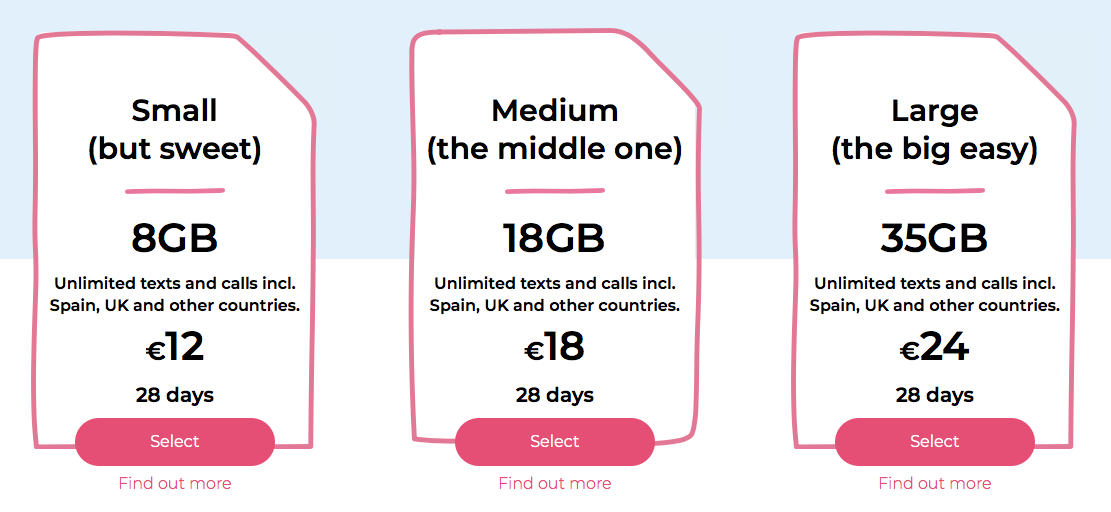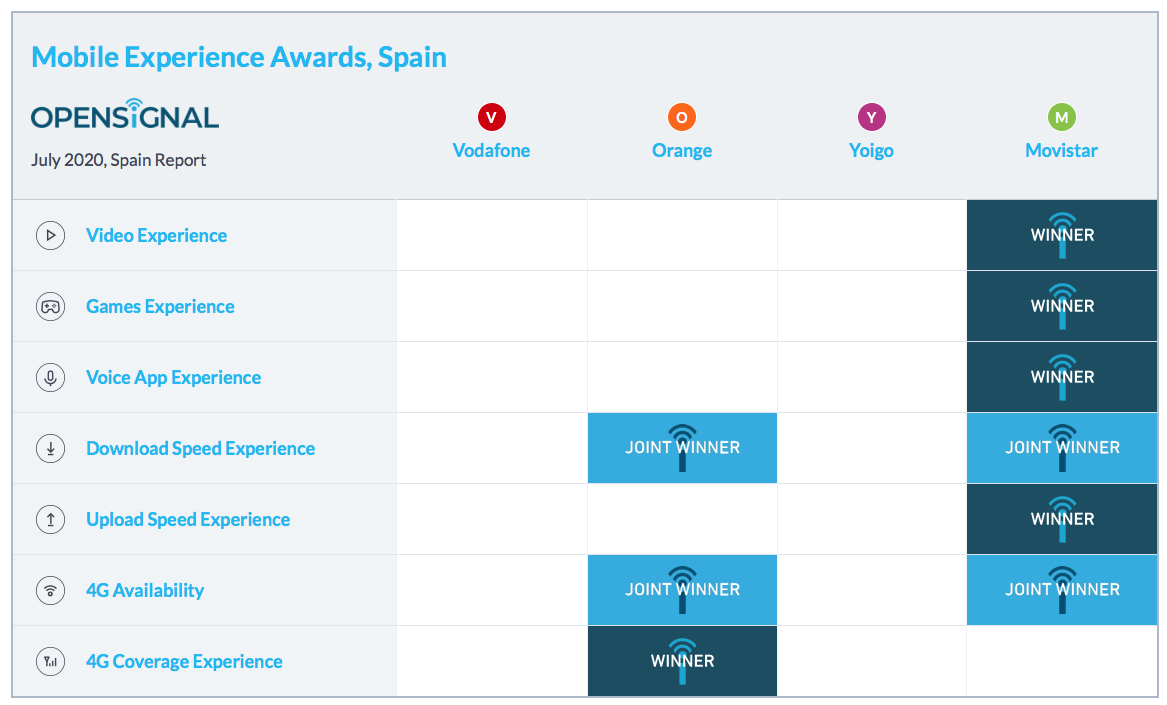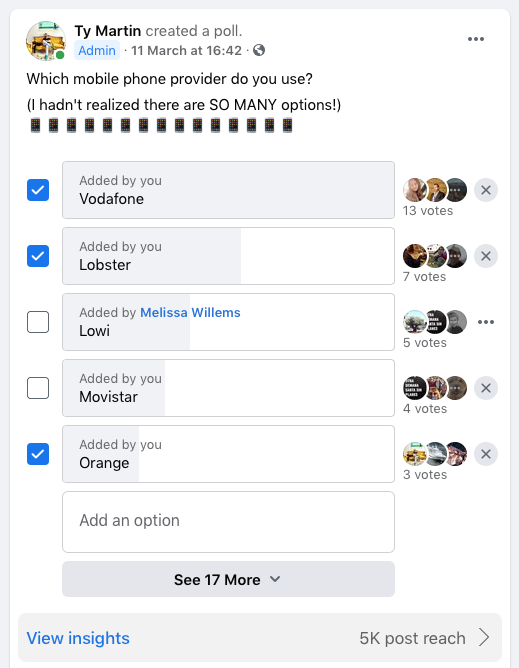
Everything you need to know to get the right mobile phone provider for your new life in Spain. Offers detailed information covering technologies/frequencies, prices, plans, MVNOs and the major providers (Movistar, Vodafone, Orange, Yoigo and Lobster. Learn which Spanish mobile providers are the fastest and which are the most popular among expats. Read one expat's plan for the best way to get a Spanish SIM before and after arriving in Spain.
If you're without an NIE, you'll be stuck with a pay-as-you-go mobile which you'll have to recharge all the time and pay higher rates. "

Mobile networks and carriers in Spain use 2 GSM bands, 2 UMTS bands, and 2 LTE bands:
Spain is a top 20 LTE country globally with a reported average LTE/4G download speed of about 28mbps (slightly down since the start of the pandemic in 2020) and average upload speeds on 4G/LTE of about 9.3mbps between all four major networks: Movistar, Vodafone, Orange and Yoigo.
4G availability has now surpassed the critical threshold of 90% for all major networks.

5G services are evolving quickly. In June 2019 Vodafone launched 5G in a handful of cities across the country while Movistar, Orange, and then finally Yoigo showing up with new 5G service availability in several cities by the end of the year. Look for more information about 5G access in Spain or post your experiences in the comments section below, including speedtests, geographic availability and response times.
Prices change monthly, so this is really just a guide. In relation to where you're coming from, you can get a rough idea of the cost of monthly minutes and data prices according to the following ratios comparing against Spanish mobile networks' prices. For your Spanish mobile phone line you'll pay about…
According to Visual Capitalist, the price per 1GB of data is about $1.83 in Spain in 2020, source: visualcapitalist.com/cost-of-mobile-data-worldwide/
So what does that translate to for your Spanish mobile monthly cost? Let's look at some examples:

Unlimited plans are only available for contract-based phones. During our research in late 2020, the shortest contract we could find was a 6 month contract on Vodafone for unlimited data. Did we get it? Nope. In the end we stuck with the prepaid SIM and got a fat 35GB/month plan.

Here is an example of Lobster (Spain's English-language mobile provider running on Movistar's network) showing their Large plan offering 35GBs with unlimited texts and calling to Spain, UK, US, etc for 24€.
Always ask about tethering (the ability to turn your phone into a wifi hotspot) to make sure it's supported by the carrier and the plan you've subscribed to. Every plan we saw included tethering, but that might not always be the case.
One of the first things to do when you arrive in Spain is get a mobile/cell phone. (In North America: cell or cell phones; in Europe and Spain: mobile phones. The same thing.) Almost everyone has at least one mobile phone in Spain and sending SMS text messages is extremely popular (as are WhatsApp, Signal, and Facebook Messenger). How dextrous are your fingers? Better get good with voice to text!

Before we go any further, the question most people want to know the answer to when they arrive on this page is – what do I need to do with my mobile phone from home to stay connected in Spain without dropping a ton of $ on roaming fees or worrying about compatibility issues?
To some extent it really depends how long you're going to be in Spain. But since this is Spain Expat, let's assume you'll be here 3+ months.
The following “plan" was adapted from a clever commenter on our Spain Expat Facebook Group assisting a mother whose American son was moving to Spain for university. This would apply to Canadians, Australians, etc, as well. Please post your suggestions in the comments for those from the U.K.!

These days nearly all mobile phones support the various bands and systems used around the world with a few exceptions that aren't relevant to this discussion. If your phone is newer than 3 years old, 99% chance it'll work just fine. The most important thing to do is getting it unlocked, as mentioned in step 1 above.
Dual SIM - Running a Spanish SIM and Foreign SIM at the same time
Imagine if you could keep your mobile phone line from home plus your new Spanish SIM phone number at the same time without porting your home number to Google Voice. Well, if you have a dual SIM mobile phone, this ultimate convenience could become your reality.
In fact, your phone probably already has dual SIM capabilities! Ever since iPhoneXs, iPhones have joined with the high-end Android devices to offer dual SIM functionality which allows you to run your old home SIM card as an eSIM alongside your new Spanish prepaid SIM card (at least that's how I have mine setup). For you iPhone users, here is the Apple Support doc to help you understand it: support.apple.com/dual-sim

For Android users, you'll need to stick to the higher end models, but some of them even have dual SIM slots. Yep, two nano SIM cards will fit.
For some interesting techno-cultural background on why the US is actually behind the rest of the world on dual SIM knowledge and capabilities, check out https://www.androidcentral.com/why dont-we-see-very-many-dual-sim-phones-us
I have T-Mobile (unquestionably the best US carrier for expats) with an all-inclusive, unlimited everything plan back home, and when traveling it gives me unlimited 3G data speeds and unlimited local calling. It may even let me call back to the US for free, but I normally use Facetime anyway. If the 3G isn't enough, I buy a 4G pass, which I did for our first month in Granada in order to reduce our frustration while wander the streets (frankly, Google Maps is
I've paired it with a Lobster Mobile SIM card (English-language mobile carrier in Spain) for local and international calling for free to most English-speaking countries. Lobster runs off Movistar's tower network, but Lobster users don't have access to Movistar's 5G network yet (reportedly – if this changes please let us know in the comments).
Speaking of 5G, in order to get it you'll have to be in one of the bigger Spanish cities with a population of 500,000 or more. Vodafone and Movistar haven't released a detailed map of their 5G network as of this writing, but I've spoken with the staff at the stores and, as of the end of 2020, it's certainly available in places like Malaga, Madrid, Barcelona and Valencia. No luck here in Granada where we need it the most (fewer fiber options and slow/poor 4G because of the terrain).

I haven't gone the Google Voice route yet because I actually want to keep my US-based line for now, but perhaps in the future I'll transfer it to a Google Voice number.
These days, most cell phones from abroad will work in Spain, just double check the frequencies (see above) supported.
You’ll be able to buy a cell/mobile phone in Spain through either the providers’ specific dealer networks, independent electronics stores or department stores like El Corte Inglés. Smaller cell/mobile phone stores are everywhere in Spain, and you can find particularly good deals on phones at the sketchier mobile phone stores often operated by immigrants. In these places you’ll probably save between €10-50 on a new phone. I’d be wary about any “used” phones offered however. Generally, the prices for new mobile phones in Spain start at €30 for the cheapest models and up to €900 for the latest models with all the bells and whistles you’d expect.
For iPhones we strongly suggest purchasing them from the official Apple Stores, which are located in Madrid, Barcelona, Valencia, Sitges, Murcia, Mar Bella, Zaragoza, and Valladolid. There are also some local Spanish chains selling Apple products in slick Apple-esque shops, such as Rosellimac, K-tuin and Goldenmac.

If you’re buying a mobile or cell phone in Spain, consider whether you would be better off with a contract or pay-as-you-go phone. When you sign a contract, you’ll have a monthly bill to pay, but you can often get cheaper rates and a free or cheap mobile phone as part of the deal. This is similar to most countries. However, you’ll need to have a NIE or possibly a TIE to sign a contract.
Even with generally higher rates, if you don’t make many calls or send many text messages in any given month, a pay-as-you-go phone may end up being cheaper. As you would expect, you only pay for what you use.
It used to be that you had to buy a phone recharge card at locutorios, grocery stores or mobile phone shops. These days it's much easier to do buy simply adding a credit or debit card to your mobile phone provider's account portal. I have mine set to auto recharge in order to take advantage of bonus data.
How to recharge your prepaid Spanish SIM from outside of Spain
Alternatively you can now recharge your phone from a couple of online services, including mobilerecharge.com and recharge.com. It's interesting to see their sites' messaging indicating that a primary use case for these online mobile recharge spanish SIM sites is a way for your friends and family to support you by keeping your mobile topped up.
Vodafone: if you travel around Europe then this is probably your best bet since they're from the UK and offer service throughout the continent."

Mobile/cell phone service providers (operadores) in Spain can be divided into two categories: those with their own networks and virtual providers who depend on others’ networks to provide their services. In general, call quality, coverage and customer service vary little across the spectrum.

OpenSignal's evaluations test the four national carriers on a variety of metrics, from download speeds to coverage to gaming performance. Movistar is the clear winner in these ranks.

Movistar (Telefónica), Vodafone, Orange (formerly Amena) and Yoigo are the four mobile phone service providers in Spain with their own network. Of these, Movistar is the oldest and most established and Yoigo the newest. I’ve experienced and heard mixed things about each of them, generally as follows:
Movistar (Telefónica):
Formerly known as Telefonica until Telefonica purchased BellSouth and unified its mobile services under the brand "Movistar" in 2005, Movistar boasts the highest marketshare of all providers at around 41%. We used to have a section of the forum called "Telefonica Rage" which should tell you something about how it felt to deal with this former state-owned monopoly. These days things are better. They offer decent rates once you’ve signed onto specific plans that accommodate your calling schedules. Their coverage isn't the best anymore, but their speed for downloads, videos and gaming is now ranked #1 per OpenSignal.com's comparison (July 2020). Movistar Spain offers 5G in the largest cities.

If you want to contribute your experience to these rankings, check out the OpenSignal app on iOS and Android. Also, we'd love to hear about your experiences with these companies to help inform other expats' mobile provider decisions.
Virtual mobile phone service providers are relatively new in Spain. These providers are able to fix their rates independently of the networks they use, and in many cases offer lower rates or other incentives, such as free call connections. These providers include: Lobster Mobile (English-language provider based in Gibraltar), Eroski Móvil, Euskaltel, PepePhone, Lebara, Carrefour Móvil and Happy Móvil. Among expats, Lobster Mobile is probably the most popular virtual mobile phone providers (English-language service and free calls to English-speaking countries being a pretty huge perk for expats), although it seems more total expats still go with Vodafone and Orange based on our informal polling.
Expect to see the next crop of virtual providers on the market any day now. Any of the mobile phone service providers in Spain may offer things such as free voicemail, credit advances for pay-as-you-go phones or other services and features, or have promotions offering free call credit, free text messages, free phones or new low rates. To get the best deal on mobile phone service in Spain, be sure to shop around with the different providers for the latest promotions and features – they change fairly often. Once you choose a provider, and depending on your calling needs, you can sign up for plans that have cheaper calling rates during certain times of the day, to certain countries, etc. Be sure to note that your provider may have different calling rates depending on which provider the person you’re calling has. Many of the mobile phone service providers in Spain offer customer service in English, including Movistar, Vodafone and Eroski Móvil. You may have to wait a few minutes before you’re put through to an English speaking agent though.

In March 2021 Spain Expat ran a poll on our Facebook group to learn more about which mobile phone providers were most popular among our English-language-focused, frequent-traveller demographic of expats living in Spain. The poll reached over 5000 expats and generated 246 responses across three Facebook groups, including Auxiliares de conversacion en Madrid, Expat Advice - Spain, and the SpainExpat Tips and Tricks group. Unfortunately due to the quirks of Facebook polls, not all of the results were tallied as poll votes, so we had to compile the some of the results from responses in the comment sections.


The results were surprising in two ways.
The slowest network is winning, at least for the moment.
Our poll showed the most raw votes for Vodafone. Vodafone appears to be the most popular Spanish cellular network among expats living in Spain by a scant margin. That might be for several reasons, including brand recognition, in particularly for those coming from the UK.
When we most recently arrived in Spain, the easiest SIM to get was with Vodafone because their shops are located at nearly every shopping/high street. They also provide 4G mifi for home network use.

Lobster ES, the English-language mobile phone network designed for expats in Spain, run from Gibraltar, and relying on Movistar's very fast 4G network is doing well with 9.5%. I would love to see them add 5G and eSIM support so that iPhone users can take advantage of the dual SIM capabilities and not have to wait for a SIM card to get delivered.
There are at least 27 mobile phone companies offering Spanish SIM cards for prepaid and contract-based cellular phone service in Spain – 27! And it appears a new one is arriving on the scene every month with a quirky logo and a funky name. The reality is that nearly every single one of these cell phone providers offers a bundle with fibre internet for the home, and some of them go one step further to bundle home internet and home electrical supply along with your mobile phone service. The competition is incredibly fierce, prices are low, and consumers are clearly the big winners.